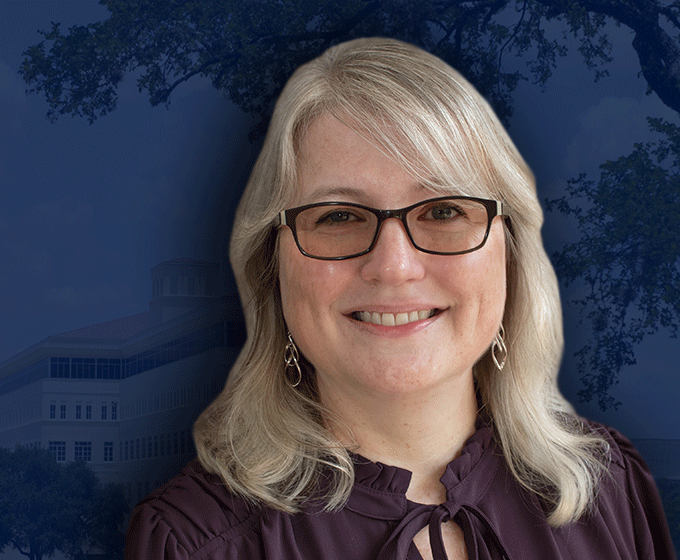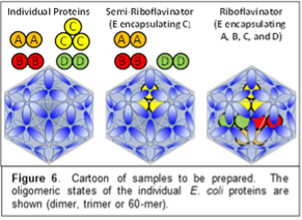
AUGUST 5, 2022 — Audrey Lamb, professor and chair of the UTSA Department of Chemistry, has been awarded a $486,000 grant from the National Science Foundation to advance her team’s research on the enzymes that produce riboflavin, more commonly known as vitamin B2.
The human body does not biosynthesize riboflavin yet the vitamin is essential to important biological functions such as DNA repair and cellular respiration—the means by which cells generate energy. Eating foods that contain riboflavin naturally is the only way to acquire it. Milk and eggs, for instance, contain relatively high levels of vitamin B2.
“When making a vitamin, the enzymes work in a particular order like an assembly line,” Lamb said. “Each enzyme adds or subtracts a few atoms to the compound made by the previous enzyme until the full molecule is built.”
Scientists’ current understanding of the biosynthesis of riboflavin was advanced by Adelbert Bacher and his research team at the Technical University of Munich in the 1990s. The researchers identified five enzymes that are required to form riboflavin.
Lamb’s lab, in collaboration with Graham Moran at Loyola University, Chicago, has been researching how the first three enzymes (RibA, RibB and RibD) perform the chemistry that Bacher’s team defined. Lamb and Moran’s most recent research paper was published in July in the Journal of the American Chemical Society (JACS).

Together, the researchers demonstrated that RibB only requires one magnesium ion for full catalytic activity, in contrast to a previous assumption of two. They also show that the starting molecule is not directly converted into the desired outcome molecule, but that the transition first requires the formation of at least two other compounds within the enzyme.
The five enzymes that make riboflavin work too slowly in a test tube to form enough riboflavin to be sufficient to support life. However, when the enzymes are located inside a cell, they work much faster.
Lamb hypothesizes that all five enzymes required to make riboflavin can be assembled into a molecular machine that her team has named the “riboflavinator.” This sub-microscopic machine, she said, acts inside the cell. Her research team is currently focused on how the enzymes come together to create riboflavin at a much faster rate than has been observed in a test tube.
Lamb’s latest NSF grant will fund research into the remaining two enzymes necessary for riboflavin production. Using the methodologies established in the JACS paper, the researchers will analyze how RibC and RibE perform the reactions they catalyze, and they will build the riboflavinator in a test tube to demonstrate that it is able to produce riboflavin faster than the enzymes would individually in a test environment.
“Think of it like this: you have an engine, some spark plugs, a catalytic converter, a gas tank and an axle system with wheels spread out on your driveway, just hanging out by themselves,” Lamb explained. “They can be shown doing their individual jobs. But they aren’t going to make much of a machine that can run down the highway unless you assemble them into a car.”
Lamb’s lab aims to figure out exactly how each enzyme does its job and contributes to producing riboflavin. This understanding could potentially lead to improved methods for treating diseases and improving public health.
“If we know how biologically important molecules, like vitamins, are made, we can figure out how to make medicines using similar chemical approaches or design molecules that act as drugs by stopping pathogens from doing these chemistries,” she said.
UTSA Today is produced by University Communications and Marketing, the official news source of The University of Texas at San Antonio. Send your feedback to news@utsa.edu. Keep up-to-date on UTSA news by visiting UTSA Today. Connect with UTSA online at Facebook, Twitter, Youtube and Instagram.
Move In To COLFA is strongly recommended for new students in COLFA. It gives you the chance to learn about the Student Success Center, campus resources and meet new friends!
Academic Classroom: Lecture Hall (MH 2.01.10,) McKinney Humanities BldgWe invite you to join us for Birds Up! Downtown, an exciting welcome back event designed to connect students with the different departments at the Downtown Campus. Students will have the opportunity to learn about some of the departments on campus, gain access to different resources, and collect some giveaways!
Bill Miller PlazaCome and celebrate this year's homecoming at the Downtown Campus with food, games, giveaways, music, and more. We look forward to seeing your Roadrunner Spirit!
Bill Miller PlazaThe University of Texas at San Antonio is dedicated to the advancement of knowledge through research and discovery, teaching and learning, community engagement and public service. As an institution of access and excellence, UTSA embraces multicultural traditions and serves as a center for intellectual and creative resources as well as a catalyst for socioeconomic development and the commercialization of intellectual property - for Texas, the nation and the world.
To be a premier public research university, providing access to educational excellence and preparing citizen leaders for the global environment.
We encourage an environment of dialogue and discovery, where integrity, excellence, respect, collaboration and innovation are fostered.